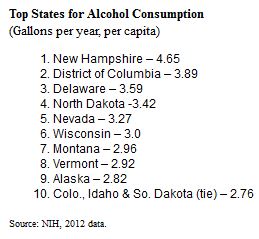Drugs & Alcohol: Patients at Risk for Alcohol–Medication Interactions

Some states, patients more vulnerable; alcohol screening can cut risk of medication interactions
By Debra Wood, RN, contributor
Millions of Americans drink alcohol, and many do so while taking prescription medications--often with serious consequences. Some hospitals are taking a more proactive stance to avoid these risks by requiring nurses to conduct alcohol screening with all patients.
“People are on multiple medications and the drug–drug interactions combined with alcohol is pretty significant,” said Dawn Williamson, RN, MSN, PMHCNS-BC, CARN-AP, an emergency department addictions clinical nurse specialist at Massachusetts General Hospital in Boston, which recently began a facility-wide, comprehensive alcohol screening and intervention program.
About 71 percent of U.S. adults reported drinking one or more alcoholic beverages in 2012, which is the most recent National Institute of Health (NIH) data available. Per capita consumption was 2.33 gallons that year, up from 2.28 gallons in 2011. The western region of the country increased the most, 3.4 percent, compared with 1.7 percent in the Midwest. Wine consumption continued on an upward trajectory, as it has since the turn of the 21st century.
States with the highest per capita consumption, 2.5 gallons or more per year, include Alaska, Colorado, Delaware, the District of Columbia, Florida, Hawaii, Idaho, Louisiana, Maine, Massachusetts, Minnesota, Montana, Nevada, New Hampshire, North Dakota, Oregon, Rhode Island, South Dakota, Vermont, Wisconsin and Wyoming.

A recent NIH study found nearly 42 percent of alcohol-imbibing adults in the United States also take medications known to interact with alcohol, including those to treat hypertension, diabetes and depression. The percentage increases to nearly 78 percent among people age 65 years or older.
Often the health effects are mild--nausea, headaches or loss of coordination--but some include internal bleeding, difficulty breathing and cardiac arrhythmias, according to NIH.
The main types of alcohol-interactive medications reported in the survey were:
• Blood pressure medications
• Sleeping pills
• Pain medications
• Muscle relaxers
• Diabetes and cholesterol medications
• Antidepressants and antipsychotics
“We are seeing more patients presenting with life-threatening complications due to harmful alcohol-drug combinations,” said Christopher Shaw, PMHNP, CARN-AP, addictions consult team NP team leader at Mass General. “On a number of occasions, we see patients on high-dose benzodiazapines and opiate medication, and they are drinking alcohol.”
Once people start drinking, it often leads to unsafe decisions. Patients mixing prescription medications and alcohol often are admitted for a fracture or other traumatic injury.
“It clouds their judgment, and they may get confused about whether they took their [prescription] medications,” Williamson said.
Rosalind Breslow, PhD, lead author of the NIH study, encouraged people to talk to their physician or pharmacist about avoiding alcohol while taking prescribed medications.
However, nurses need not wait for patients to inquire about alcohol–medication interactions. Nurses can screen patients and educate patients about the risks.
The Joint Commission requires all cognitively intact adult inpatients be screened within three days of admission for unhealthy alcohol use. The accrediting organization states that “hospitalization provides a prime opportunity to address substance use, and for many patients, controlling their other health problems requires addressing their substance use.”
In response to a community health assessment, Mass General made addressing substance abuse, including alcohol, part of its 10-year strategic plan. In September, nurses began screening every patient admitted using the Alcohol Use Disorders Identification Test (AUDIT-C) validated screening tool, asking everyone--from those arriving in the emergency department to patients scheduled for elective procedures, such as knee replacements--how often they drink alcoholic beverages, how many standard drinks with alcohol are consumed in a typical day and how often they have six or more alcoholic drinks on one occasion.
“This is included in the general nursing assessment, and it de-stigmatizes questions about alcohol or other substances,” Williamson said. “It [tells nurses] whether they are at high risk, moderate risk or low risk of having an adverse health outcomes related to their alcohol use.”
Mass General provided education to all of its nurses about how to screen patients with the AUDIT-C tool, and how to respond once the tool was scored. With those at low risk but taking a medication that interacts with alcohol, the nurse will provide education about potential consequences while praising the moderate consumption. At moderate risk, the nurse tries to motivate the patient to cut back and eliminate risky behaviors and will refer for an additional assessment as needed. For high-risk patients, the nurse tries to convince the patient to accept a referral and will discuss with a member of the Addictions Consult Team about what steps are needed.
Prior to initiating the comprehensive screening, Williamson said, many admitted patients would go into withdrawal, because they did not have access to alcohol.
“This is a way to be preemptive,” Williamson said.
Mass General also is encouraging nurses to become certified as an addictions professional, because so much of it is seen on medical-surgical units.
Alcohol screening and nursing assessment tools:
• The American Public Health Association has produced a white paper, “Alcohol Screening and Brief Intervention: A Guide for Public Health Practitioners,” available for free download to help health care professionals learn the best approaches for screening and educating patients.
• The National Institute of Alcohol Abuse and Alcoholism also offers professional educational materials.
• An overview of the AUDIT-C alcohol screening tool is available from the SAMHSA-HRSA Center for Integrated Health Solutions.
© 2015. AMN Healthcare, Inc. All Rights Reserved.